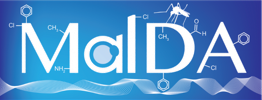Mapping the malaria parasite druggable genome by using in vitro evolution and chemogenomics.
Journal:
Science (New York, N.Y.), Volume: 359, Issue: 6372Abstract:
Chemogenetic characterization through in vitro evolution combined with whole-genome analysis can identify antimalarial drug targets and drug-resistance genes. We performed a genome analysis of 262 parasites resistant to 37 diverse compounds. We found 159 gene amplifications and 148 nonsynonymous changes in 83 genes associated with drug-resistance acquisition, where gene amplifications contributed to one-third of resistance acquisition events. Beyond confirming previously identified multidrug-resistance mechanisms, we discovered hitherto unrecognized drug target-inhibitor pairs, including thymidylate synthase and a benzoquinazolinone, farnesyltransferase and a pyrimidinedione, and a dipeptidylpeptidase and an arylurea. This exploration of the resistome and druggable genome will likely guide drug discovery and structural biology efforts, while also advancing our understanding of resistance mechanisms available to the malaria parasite.
